Shakhtar Donetsk have gained a reputation for being one of the most attractive attacking sides in European football. When the Brazilian revolution started in January 2005 with the signing of Jadson, Donetsk had won only one league title. Since then former coach Mircea Lucescu has formed a team that won eleven league titles, one UEFA cup, and has become an ever-present in European competitions.
When talking about Shakhtar, the first thing that comes up is the Brazilian connection in the attack. Looking around Europe, there are numerous players who made their first steps in Europe at Donetsk. The club from eastern Ukraine has set up a highly successful scouting network in South America that allows them to buy young talents for a relatively low fee compared to players of a similar level from Europe. These tactics have not only brought sporting success but also financial success.
However, in recent years it has become a bit quieter around the Ukrainian club. While they are still a regular guest in the Champions League, they were hardly able to surprise and beat – on paper – superior opponents. Additionally, besides Fred, they haven’t sold any players for significant fees in the last four years. In this tactical analysis, we will take a closer look at their current squad and the philosophy that shaped the club. Besides, this scout report will examine the tactics under head coach Luis Castro.
Player trading and the difficulties of assessing Shakhtar
Before we dive into an analysis of Shakhtar’s current roster and their playing style, it is worth looking at their general philosophy they developed since Mircea Lucescu was appointed as head coach in 2004. It is not an exaggeration to say that Donetsk have successfully gamed football’s multi-billion transfer market: buying low, selling high, while maintaining a team of 11 players capable of competing against Europe’s elite. Funded by billionaire Rinat Akhmetov, who bought the club in 1995, they were able to pay significant transfer fees every season including high salaries.
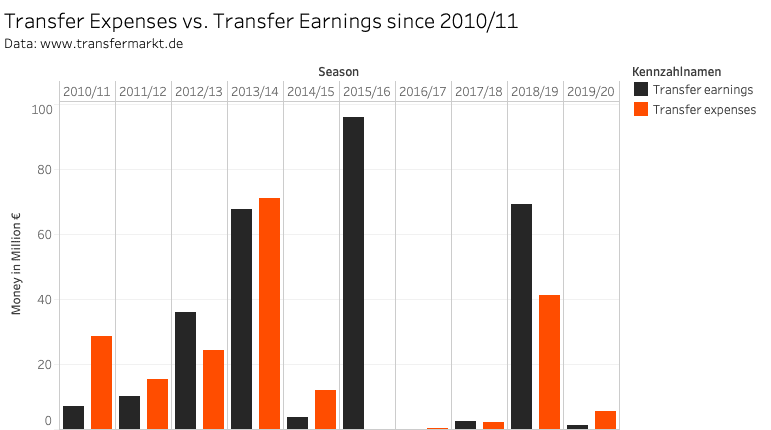
Nevertheless, it’s by no means only the money that allowed them to attract Brazilian talents to Ukraine. Players are aware that they have great opportunities in Donetsk to develop and play regularly in the Champions League giving them a platform from which they can convince bigger clubs to acquire them. This reputation has allowed them to be economically efficient by buying talented players from South America who have the right attitude to play in Europe.
However, when the Russian military intervention in Ukraine started in 2014, things drastically changed in many perspectives. Because of that, Shakhtar were not able anymore to play their home games in their own Donbass Arena, which was just opened in 2009 but had to travel to Lviv in the Western part of Ukraine. Since early 2017, the club has held its matches in the Metalist Stadium in Kharkiv after the collapse of Metalist Kharkiv. Their home games in the league only attract 6,682 fans on average in the Ukrainian league. In light of the crisis and the deficit by playing in Lviv, it became difficult to attract new talents and also explains the significant transfer earnings in 2015 as players were keen on leaving the club. After some difficult periods, Shakhtar just started to buy new talents in the summer of 2018 after Fred’s sale to Manchester United to refresh their squad.
Lastly, before analysing their squad, it’s important to mention the differences in terms of strengths between Shakhtar’s opponents in the league and in European competitions. The Football Club Elo Ratings, which offer an estimation of football clubs’ and leagues’ strengths, rate Donetsk’s opponents in the league at 1401 compared to 1829 in the Champions League. It’s worth keeping that in mind as it almost inevitably leads to adjustments in the style of play.
Squad and System
After the departure of Paulo Fonseca last summer, Luis Castro was appointed as the 33rd head coach of Shakhtar Donetsk. The 58-year-old has worked in the youth academy of FC Porto for almost seven years until 2013 before he eventually coached the B team and started his coaching career for the second time. The biggest success was the 5th place last year with Vitória Guimarães SC that secured a spot in the Europa League.
When looking at Shakhtar’s current roster, we can see that many players are already beyond or in the latter stages what can be considered their peak. In fact, the squad consists of eight players in their peak age, of whom only Alan Patrick and Sergij Kryvtsov get significant minutes. That said, Shakhtar have tried to refresh their squad through the addition of several youngsters in the summer of 2018. So far, only Tete and Dodo have seen significant amounts of minutes on the pitch, while Marcos Antonio is on the best way to do so.
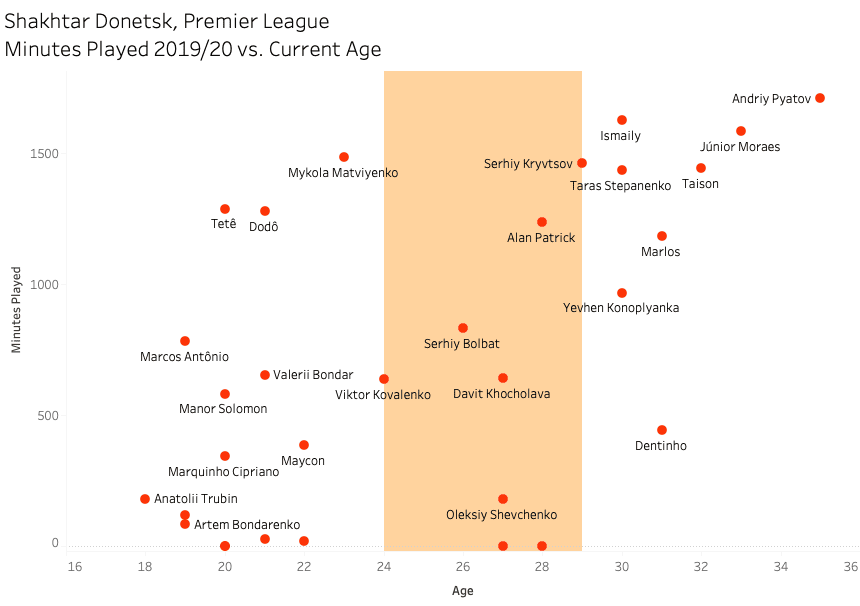
Their formation depends a bit on the opponent and accordingly, on the competition. In the Ukrainian Premier League, Luis Castro deploys a 4-2-3-1 formation with one of Brazilians Taison or Marlos acting as a playmaker. In European competitions, the approach is a bit more conservative and frequently sees Kovalenko coming into the team. The 24-year-old Ukrainian has started in more European games (six) than league games (five). He’s not as spectacular and technically gifted as his Brazilian teammates but more disciplined and aggressive against the ball. This allows Shakhtar to defend in a 4-1-4-1 to minimize the space in the center. In possession, Kovalenko usually moves higher up the pitch to create the usual 4-2-3-1 with Alan Patrick dropping a bit deeper.
Most minutes have been played by Shakhtar’s goalkeeper which is still the ever-present Andrij Pyatov, who has been at the club for 13 years. Notwithstanding his age of 35, he is still a solid keeper despite some occasional errors. Nevertheless, sooner or later, a change seems inevitable with academy player Anatoliy Trubin luring for his chance. The 18-year-old already made his first appearance just before the league was suspended due to Covid-19.
At centre-back, Luis Castro trusts Sergij Kryvtsov and Mykola Matvienko, both of whom are decent defensively. While Kryvtsov sometimes looks a bit clumsy with the ball, Matvienko can also play some decent diagonal long balls in memory of Yaroslav Rakitskiy.
After Dario Srna had been an evergreen at Donetsk for many years, his successor is the 21-year-old Brazilian Dodo. When watching Dodo, there are many similarities to his countryman Rafinha who had a very successful time for Bayern Munich. Both players are small but very aggressive and like to join the attack with overlapping runs down the flank. His counterpart on the left side, Ismaily, is a similar type of player although nine years older. With a lot of athleticism, he runs up and down the left side, relentlessly exploiting empty spaces in wide areas while excellently interacting with Taison.
The most defensive-minded player apart from the defence is Taras Stepanenko, who joined the club in 2010 and has been a regular starter ever since. He’s often under the radar because of his unspectacular playing style but by doing so he secures the balance and serves as a counterpart for his Brazilian teammates. In possession, he generally occupies a deeper role sometimes dropping between the centre-backs to form a back three. When playing with a double pivot, he’s usually joined by the technically gifted Alan Patrick. Alan Patrick is not the most athletic player but someone who rarely loses his calm and always finds solutions with the ball.
In front of them, Luis Castro generally rotates between five players: Taison, Marlos, Tete, Kovalenko, and Konoplyanka. Taison and Marlos are very similar in their style. Both like to operate from the half-spaces and enjoy a lot of freedom in their movements. Taison in particular tends to move around the whole pitch, always looking for pockets of space that can be exploited. Tete is a different type of player as he also likes to receive the ball in wider areas to make use of his pace.
The man upfront is Junior Moraes, who rarely leaves his position and ensures that there’s always some kind of depth in Shakhtar’s game. The 33-year-old is not so much involved in combinations but waits for the right moment to put the ball into the net or lay it off for his Brazilian mates. However, this has worked quite well so far this season with 17 goals and seven assists in 19 league games. In Europe, he amassed three goals and two assists.
Maintaining width with a central focus
Offensively, they currently average 2.19 xG/game in the league, overperforming by more than eight goals. The general structure of Luis Castro’s squad in possession is a 4-2-3-1 formation. Their approach is very flexible and consists of many rotations of the offensive players. As has been the case for years, the core of this approach consists of the offensive players, who take up very central positions between the lines. Marlos and Taison specifically like to be positioned more centrally and move from wide positions into the opposing channels to operate between the lines. Despite their focus on the middle and half-spaces, a general principle of the Eastern Ukrainian side is their continuous occupation of the flanks. Maintaining this width is mostly done by the advancing full-backs.
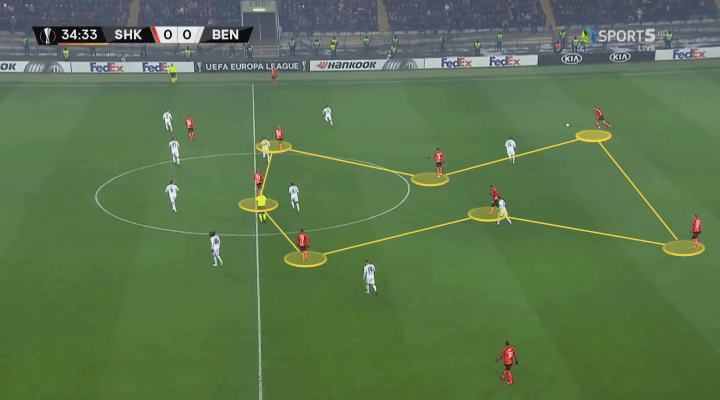
As shown above, Shakhtar’s build-up usually starts with the two centre backs, who are sometimes supported by the pivot to form a back three depending on the opponent. The centre-backs are positioned wider than the central midfielders, who sit in the middle of the pitch. This allows the centre-backs to build up through the half-spaces or play the ball into wider areas.
What’s worth noticing is the positioning and staggering of the central midfielders. Regardless of whether Luis Castro deploys a 4-1-4-1 or a 4-2-3-1, you will mostly see two central midfielders in a relatively narrow position at similar height. Another player, either the pivot or the playmaker, will act behind or in front of them. Here, we can see an instance, where Stepanenko drops between the centre-backs to build a back three.
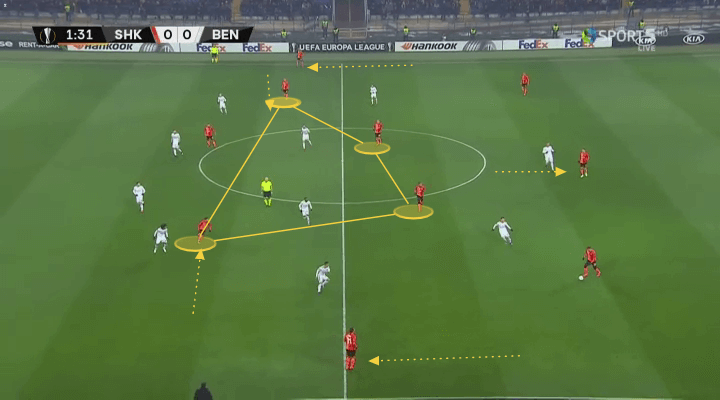
Furthermore, we can also see some asymmetrical shapes in Shakhar’s buildup to create numerical superiority in wide areas. We already indicated the freedom of Taison or Marlos, which allows them to take up wide positions. These asymmetrical shapes also fit the 20-year-old Tete, who’s a different player type and comfortable receiving the ball in wide areas. A rectangular or diamond-shaped positioning emerges by the remaining midfielders.
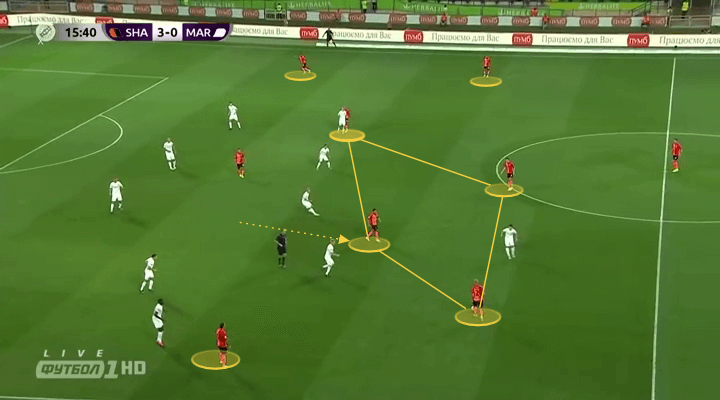
While there are some patterns recognizable in Shakhtar’s build-up, they don’t have one clear structure. Instead, it relies on flexible adjustments and appropriate staggering of the attacking players. Taison can turn up everywhere to drop out of the second line cover and support the build-up as we can see below. The opponent’s advancing central midfielder tries to close down Shakhtar’s centre-back and prevent him from building up. This scheme is manipulated by Taison who drops deeper to receive the ball.

The use of half-spaces
Particularly in the league against teams with a low block, the half-spaces possess a crucial role for Donetsk. Their PPDA against is 15.32 and underlines the passivity of opponents. The opposing teams regularly sit very deep to minimise the spaces Donetsk’s attackers can occupy in. Consequently, it’s up to them to create this space. Most frequently it’s Taison who fulfills the crucial role as a free-flowing central attacking midfielder. It’s worth noticing that Shakhtar is very patient and rarely opt for overconfident long-range shots. Instead, they seek gaps to shoot from good positions which is underlined by 0.15 xG/Shot.
If passing lanes into the centre are blocked, Shakhtar frequently builds up through the left side to eventually get the ball into central zones. The importance of the left side mostly consisting of Taison/Konoplyanka and Ismaily can be illustrated by an exemplary passing map of the match against Benfica.
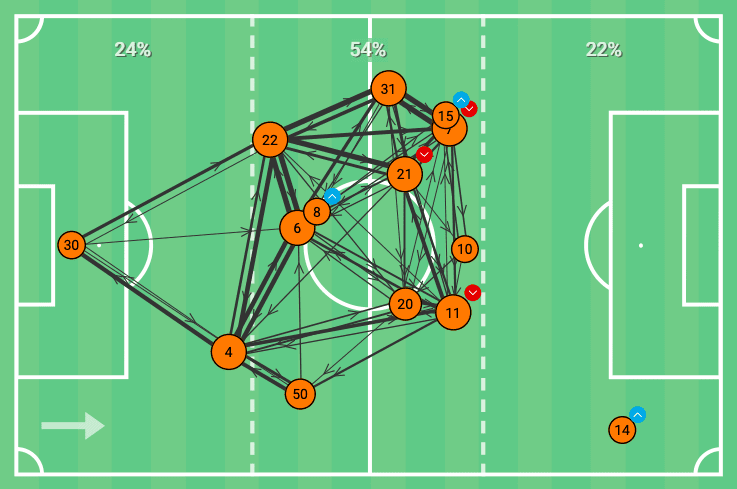
When Shakhtar’s left-back receives the ball deep in the opponent’s half, it’s usually the left winger or the attacking midfielder who drops out of the second line cover to offer a diagonal passing option into the centre. The initial pass to the full-back can attract the opponent to wider areas, just to return to the centre from there. When the dropping player receives the ball in the half-space, he has the field in front of him and can put in a through ball or just shift the play quickly to the other side. Interesting in the instance below are also the runs of the striker and the right winger. As they start runs from behind, they push the opponent’s last line deeper because they dropped accordingly, which opens more space between the lines.
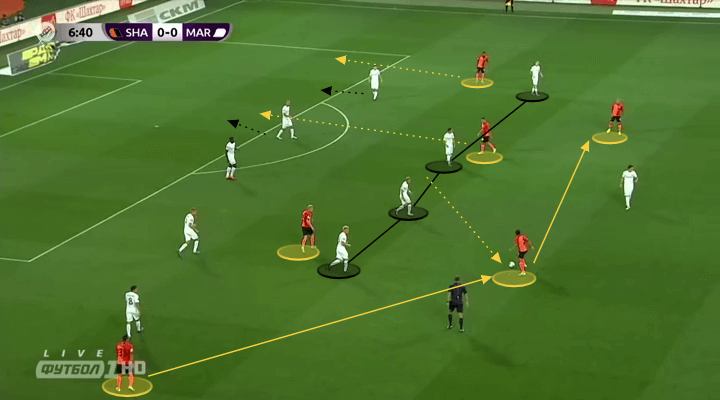
This kind of situation is often used to shift the ball directly from one half-space to the other half-space. Thereby, the attacking team can cross two zones, which forces the opponent to react even quicker to close the emerging gaps. This is more effective than only crossing one horizontal zone and frequently used by the Ukrainians.
One of the most important aspects of Shakhtar’s centre-focused tactics is the ability to quickly overload the half-spaces. Due to the high number of players in the middle and the two half-spaces, it is easily possible to switch positions and move into another zone. It enables the Brazilian players to combine within pockets of space with variety and flexibility. When faced with overloads in these spaces, opponents tend to drop deeper and deeper. At one point, they frequently become too deep and lose access to defend the space in front of them and neglect the flanks. This makes them vulnerable to progressions from these areas and is a problem of blindside defending as they try to overcompensate certain areas.
In the example below (following the last picture), we can see an extremely deep block with Marlos dribbling inside from the right side and Taison moving over into the opposite direction to use pockets of space that emerged in the right half-space. When he receives the ball due to a lay-off from Marlos, he can exploit the gap with a pass in between the opponent’s left centre-back and left-back.
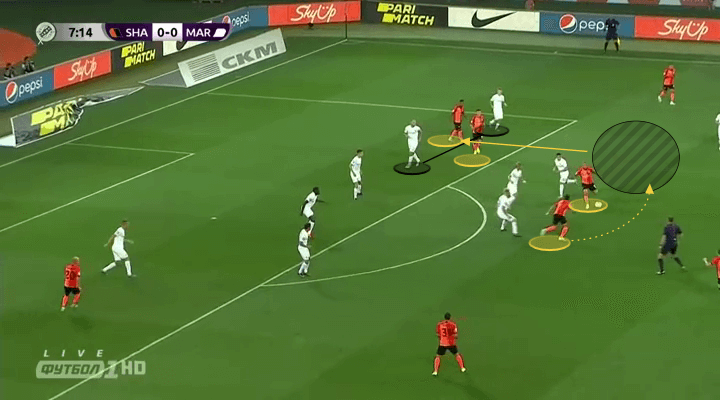
In other instances, they might overload the ballfar half-space to create numerical superiority. As the opponent is concentrated on the ball-carrier, the diagonal pass from Taison allows his team to gain space by playing vertically and at the same time shift the play while the receiver still has a good field of view. This allows Donetsk to gain space and get into more threatening positions. When the striker positions himself in the ballfar half-space, he pins the ballfar centre-back when making a diagonal run into the channel. This allows Marlos to make a deep run in behind to exploit the gap.
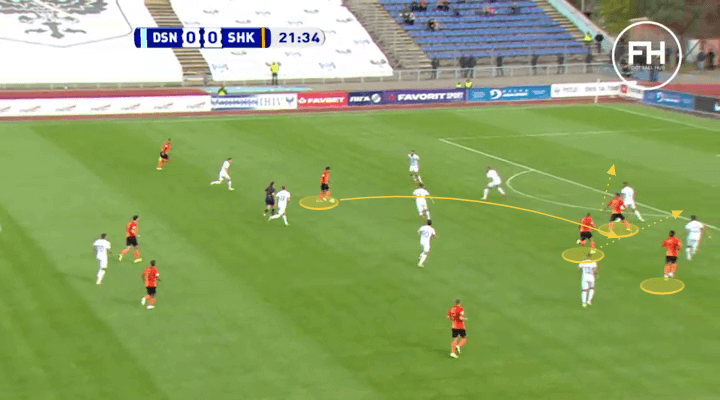
Regardless of how Shakhtar eventually progress the ball and create chances, a crucial aspect that also has to be emphasized are the dribbling abilities of their players. Apart from the Ukrainian defensive players, everyone is able to evade pressure due to quick movements and rarely lose their calm. Especially against low blocks, this can be hugely effective as this can open up new gaps and change the opposition’s defensive structure. Unsurprisingly, they average the highest number of dribbles per game (37.35) at a success rate of 56.9%.
Advancing full-backs
Shakhtar have a far inferior percentage of ball possession in European competitions with 51.66% compared to 63.42% in the league. This fact combined with a higher last line of their opponents allows them to put more emphasis on quick counterattacks.
The advancing full-backs are an essential part of Shakhtar’s play and have been particularly successful in European competitions. Small sample size, but Dodô absolutely shone through his performances, averaging 0.78 Goal Involvement per 90 in Europe. His forward runs from a defensive position in full speed past the winger into the open space behind the opposition defence have proven to be particularly effective when counterattacking. They allow Shakhtar to create numerical superiority with a 2 vs 1 situation.
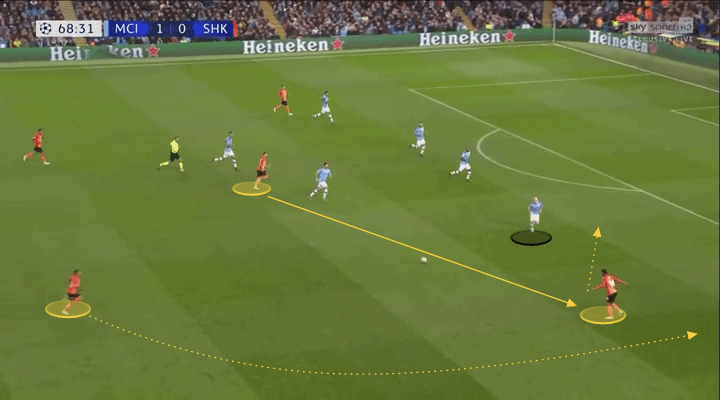
When breaking through on the flanks, the full-backs almost never operate with high crosses. Given the height of their attackers, this comes as no surprise. Instead, they always look for a flat cross, oftentimes against the running direction of the defenders to allow Shakhtar’s attackers to run in from behind.
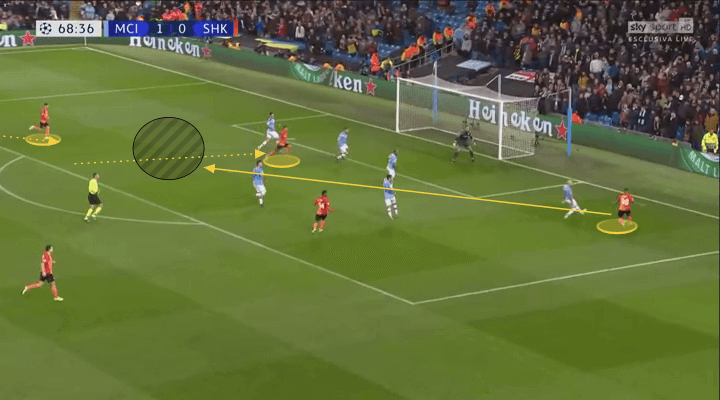
Generally speaking, Luis Castro’s side doesn’t operate with many crosses at all, averaging only 12.26 per game, which is the second-lowest in the Ukrainian league and a significant difference compared to their closest persecutor Dynamo Kiev, who lead in this category with 19.72 according to Wyscout.
Coming back to Dodo all of his assists have emerged through counterattacks. As the opposing wings don’t track back quickly enough, the 21-year-old can make use of his pace and exploit the space behind the defence. Furthermore, sometimes the overlapping runs don’t result in a cross but serve as a manipulation to catch the attention of the opponent. This enables the ball-carrier to dribble inside or look for a teammate
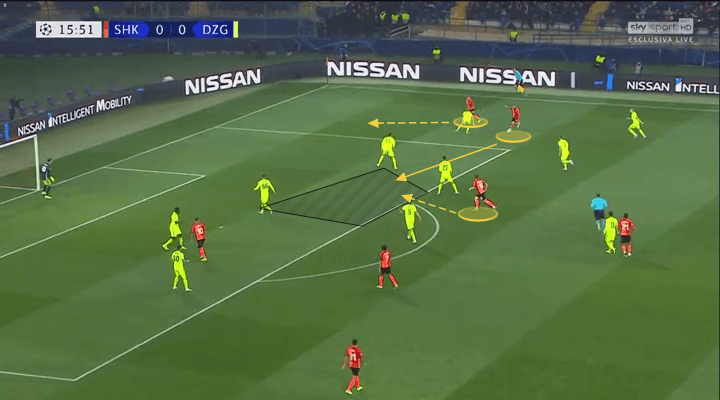
Defensive set-up
Even though Shakhtar only conceded 15 goals in 23 league games, their expected goals against value is significantly worse than in recent years. 0.88 xG against per 90 means that they currently overperform by more than five goals according to Wyscout. In Europe, their value is 1.88 per 90.
Similar to the approach in possession, Shakhtar don’t have one pressing scheme against the ball that’s always used. Luis Castro’s team usually defends in a medium block while occasionally pressing higher up the pitch. Depending on the opponent’s set-up, Shakhtar’s structure against the ball resembles a 4-1-4-1, 4-3-3 or 4-4-2.
High pressing situations are mostly used in the league and against inferior or even opponents in European competitions. Particularly against Ukrainian sides, they like to lure the opposition into pre-defined spaces and eventually collapse around the ball and win it back. One reason for that is certainly the lower technical and individual quality of the teams in general. Teams are rarely able to solve this kind of situation under pressure, which could lead to dangerous situations for Shakhtar.
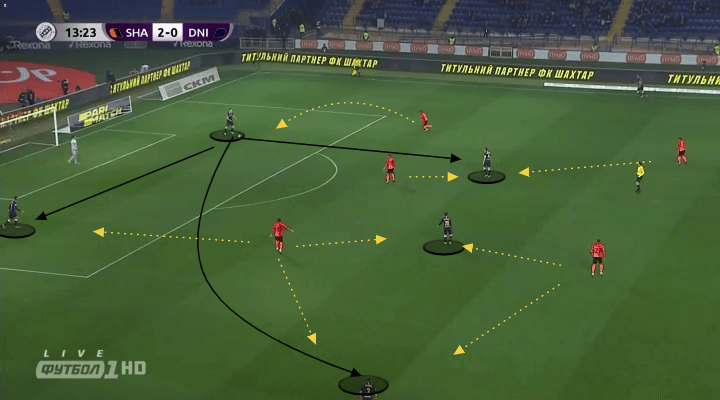
A typical pressing trigger are lateral passes from one centre-back to the other or passes from the goalkeeper to a centre-back. Shakhtar’s striker Júnior Moraes makes a curved run to close down the passing option towards the other centre-back again while one of the wings attacks towards the centre using his cover shadow. In midfield, vertical passes are prevented through a man-marking approach of the 8s, leaving the opponent with only two options: long ball or pass back to the goalkeeper.
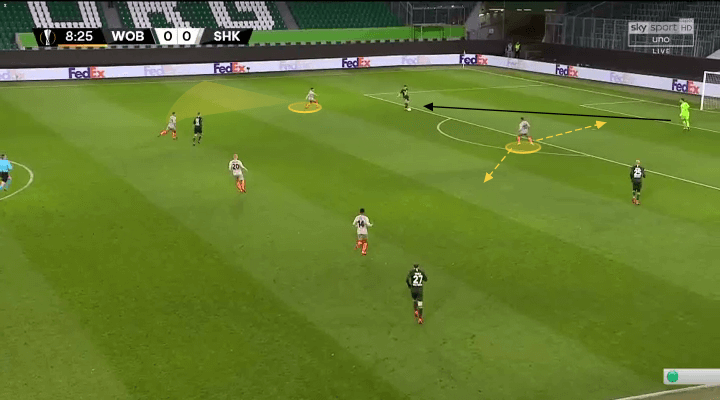
When Shakhtar become too passive
Shakhtar are always able to score a goal thanks to the quality of their offensive players. However, their defensive set-up leaves something to be desired. In nine matches, they have already conceded 18 goals, which eventually cost them the chance to reach the round of 16 in the UCL.
Defending relatively deep, Shakhtar can become too passive at times allowing the opponent to progress the ball easily into dangerous zones. This was particularly visible in the second half against Atalanta Bergamo and the first half against Benfica Lissabon. As mentioned, the preferred 4-1-4-1 of Luis Castro, which can become a flat 4-5-1, should ensure compactness in the centre. That requires his player being close to each other and appropriate staggering.
A crucial space of the 4-5-1 structure is the offensive half-space between the striker and wingers as there inevitably arises a gap if nobody advances. This allows the opponent’s centre-backs and pivot to rotate the ball undisturbed looking for the right moment to break Shakhtar’s lines. The missing staggering then allows the opposition to play the ball into the horizontal zone between Shakhtar’s two lines.
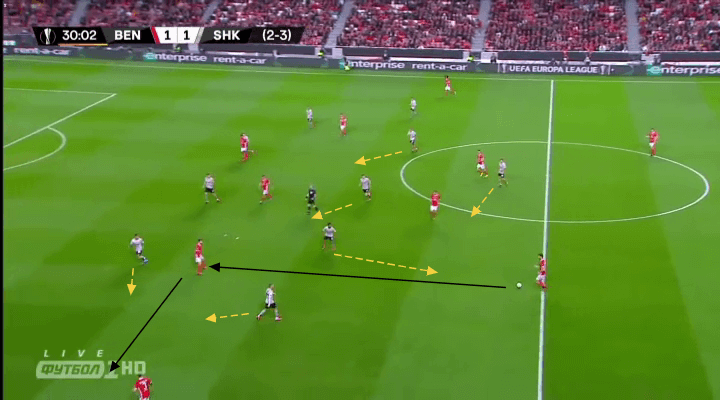
Thereby, a 2 vs 1 situation can be easily created if Dodo doesn’t step up. If he does so, he has to be sure to have the right timing to get the ball or prevent the attacker from playing wide. That said, Dodo acts rather risk-averse and frequently drops a bit deeper paying attention to the full-back, who pushes up.
As illustrated above, this could have been compensated with the ball-near central midfielder pushing up to apply pressure on the opponent and use his cover shadow to prevent the pass into the centre. A resulting gap can be quickly closed by the pivot, who already started in this direction. Due to the shifting movements in a 4-5-1 structure with advancing 8s, the gaps can be continuously closed and inhibit the opponent from playing through the defensive structure with two simple passes.
Conclusion
This tactical analysis has outlined the principles of Shakhtar Donetsk in possession as well as against the ball. Despite their aging squad, this scout report has shown that Shakhtar still have some pretty exciting and technically gifted players that are very enjoyable to watch. However, we also saw that they sometimes lack defensive discipline.
What the future for Shakhtar holds is currently almost impossible to predict. Nobody can say in good conscience how the transfer market will be affected due to Covid-19 and whether the leagues can be continued or not. However, Shakhtar made the first steps to refresh their squad with new promising Brazilian talents who might become an integral part in the future. If they develop further, we will soon hear again about enormous transfer sums, which are offered for Brazilian stars of Donetsk.

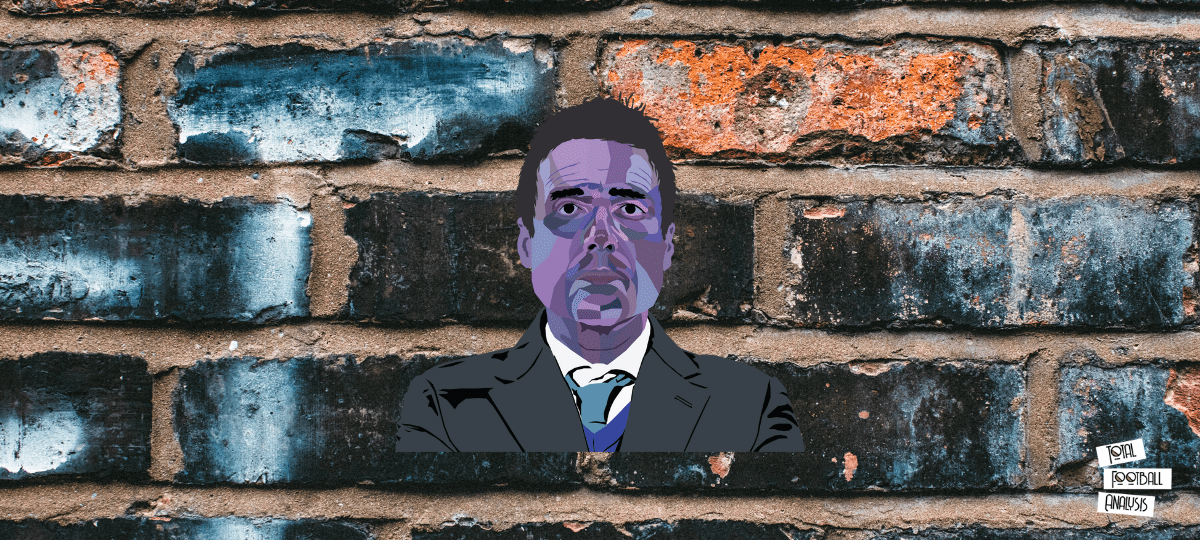



Comments